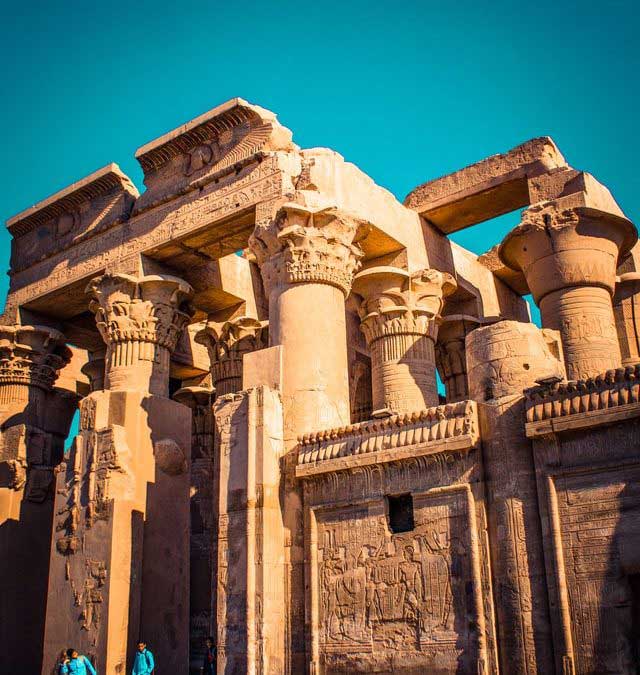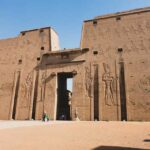Along with Esna and Edfu, Kom Ombo is the third major stop that most of the Nile cruises between Luxor and Aswan make on their journey. Located only 30 miles north of Aswan, it is also easy to visit Kom Ombo on a daytrip by car from Aswan.
however, The setting of this Temple of Sobek, the crocodile god, makes an approach by water the far superior way to visit this site. The temple is perched atop a picturesque bluff alongside the river and while there are no longer any crocodiles in the river or in the sacred lake inside the temple complex, t
his riverside temple is still worthy of a visit.
Like the other two sites between Luxor and Aswan, Kom Ombo dates from the Ptolomaic Dynasty and it was only completed under Roman rule. The temple has a dual dedicatation to Sobek, as well as Horus, and the plan of the temple reflects this dual purpose.
This article contains information for NON EGYPTIANS who wish to visit Kom Ombo Temple including:
- Where is the Temple of Kom Ombo located?
- How old is Kom Ombo Temple and who built it?
- Kom Ombo Town
- The best way for visiting Kom Ombo Temple
- How much does it cost to visit the temple of Kom ombo?
- The ancient Egyptian mythologies about Kom Ombo Temple
- The design and layout of Kom Ombo Temple
- Recommended Tour packages to Egypt Including Kom Ombo Temple
Where is Kom Ombo temple located?
The Temple of Kom Ombo is an unusual double temple in the town of Kom Ombo in Aswan Governorate, Upper Egypt. Back in time, the temple took place between the Nubian trade routes and the gold mines in the eastern desert, later, it became a training depot for the wild animals used in the war during the role of Ptolemy VII to fight the Seleucid empire, it was built during his reign as well .the area that the temple was constructed on used to be a favorite spot to the crocodiles to lay under the sun on the Nile shore, so it’s make sense now to be dedicated to the crocodile god
How old is the Temple of Kom Ombo and who built it?
It was constructed during the Ptolemaic dynasty, 180–47 BC. Some additions to it were later made during the Roman period. Kom ombo temple was built 180 years ago (B.C) by the Ptolemaic dynasty during the Roman invasion, what’s so special about the temple of Kom ombo that it stands right on the river bank between Edfu and Aswan which makes it a wonderful stop station for Nile cruises and a main highlight of Aswan attractions .the temple is dedicated to two gods, Sobek the crocodile god and Haroeris (the falcon god Horus), it is weird for any Egyptian temple to be set up for two gods ,it’s just unusual to have double dedication. Bastet Travel agency has already provided Egypt tours that include Kom ombo temple visits
Kom Ombo Town
Kom ombo is a small town located on the west bank of the Nile between Edfu and Aswan city, it was once a landscape covered with sand and maybe that’s why the Arabs called it Kom which means (small mountain) because formerly it was desert and sandy hills before the excavations and that the distinct feature of the town (kom ombo temple ) stands on a small hill overlooking the Nile. today, thanks to the irrigation, agriculture and sugar cane plantations which extended to cover almost 12,000 hectares, this industrial movement led to developments to all the villages of Kom ombo making it industrial centers, in addition of hospitals, schools, sugar refiners were established all over. The stones of Kom ombo temple actually differ from any other temple, and what makes the temple really stands out is the exceptional background of the fertile land, direct view of the Nile and the granite rocks on the shore.
The best way for visiting Kom Ombo Temple
If you’re exploring Egypt on a cruise trip, the Temple of Kom Ombo is usually the first stop after leaving Aswan. Trains stop at Kom Ombo on the line between Aswan and Luxor (which goes on to Cairo too), although are very often delayed. Hiring a car with a driver from Aswan is the most flexible option, if you can haggle them down to a good price for a return journey and waiting for you while you explore the temple.
The easiest option is booking a guided excursion or cruise, many of which combine other important temples and monuments, so that you don’t have to worry about travelling between the different sights or trying to find an English-speaking guide.
How much does it cost to visit the Temple of Kom Ombo?
Tickets, which cost 140 Egyptian pounds (approximately $9) for adults and 70 Egyptian pounds (or $4.5) for students, can be purchased at the entrance’s visitors center. All tickets include access to the main temple of Kom Ombo and the crocodile museum.
The ancient Egyptian mythologies about Kom Ombo Temple
Ancient Egyptian had very special religious believes, they had many gods and goddesses each one indicates some morals motivated the Egyptian to dedicate them worshiping temples ,in Horus and Osiris myth the Egyptian god Seth refers to evil and darkness which somehow changed his skin to be a crocodile in order to escape, the right side building of Kom ombo temple is for Sobek (a form of seth), his wife Hathor and their son (khunso).the Egyptians believed if they worshipped and honored dreadful crocodiles as gods they would protect them from attacks ,However, the left side building of the temple is set up for Haroeris (form of Horus) and his wife. Roman emperors were so admired and impressed by the Egyptian mythologies ,they recognized well how much the ancient Egyptian were passionate about their gods so they portrayed themselves with Egyptian god figures to win respect and loyalty of common Egyptians . you’ll find the Roman emperor Domitian seen on the entrance pylon with the divine triad Sobek,Hathor and Khonsu beside 52 long lines of hieroglyphic writings , as well as ,emperor Tiberius who is shown on the columns of the temple as he rendering homage and making offerings to the gods .
The design and layout of Kom Ombo Temple
The building is unique because its ‘double’ design meant that there were courts, halls, sanctuaries and rooms duplicated for two sets of gods. The southern half of the temple was dedicated to the crocodile god Sobek, god of fertility and creator of the world with Hathor and Khonsu. Meanwhile, the northern part of the temple was dedicated to the falcon god Haroeris (“Horus the Elder”), along “with Tasenetnofret (the Good Sister, a special form of Hathor or Tefnet/Tefnu) and Panebtawy (Lord of the Two Lands).”The temple is atypical because everything is perfectly symmetrical along the main axis.
It is a symmetrical mirror of itself along its main axis with one half devoted to each of the two gods it honors. Like at Esna, the pylon entrance to the temples is no longer standing, leaving the hypostyle hall as the main feature that visitors see today. Also on the grounds of the temple is the Crocodile Museum, which has a display over crocodile mummies.
It is a double temple each side dedicated to one god of Sobek and Horus ,the two sanctuaries buildings are perfectly symmetrical ,almost a twin temple ,linking between them similar passageways lead to the outer parts of the temple. Some renovations were made later, such as the hypostyle hall which was added by Ptolemy the seventh 51-47B.C, Moreover, under the role of emperor Trajan 53-117AD, the forecourt and outer walls were added, the entrance gate of the temple complex assumed to be built by Cleopatra’s father Ptolemy XII. The walls of the temple painted with repeated offerings scenes to the gods by the pharaohs of the Ptolemaic period, and include Cleopatra VI.
The outer hypostyle hall
The main feature of kom ombo temple is the hypostyle hall full with fifteen columns decorated with some lotus floral capitals and sun images, the bases of the columns are decorated with Lilly as a symbol for upper Egypt and papyrus which is a symbol for Nile delta, However, the roof is decorated with flying vultures. since the common people were very influenced by religious thoughts, The Egyptian pharaohs linked themselves to gods in order to appear to their folks as chosen kings by deities, so we can see Ptolemy XII painted on the outer and inner walls of the temple purified by Horus and being crowned by Haroeris, other carvings shows him making offerings to the same gods beside Sobek, Isis and lion headed god. There’s a large round located west of the outer hypostyle hall called the “sacred wall” which was used to measure the depth of the Nile, also there’s a small pool was for raising sacred crocodiles where uncovered crocodile mummies were found nearby.
The inner hypostyle hall
the inner hall has ten thin columns which has some engravings of Ptolemy II making offerings to the gods while his brother making some offerings to Haroeris at the back of the hall as well. the south wall shows paintings of Sobek , the southwest corner shows Ptolemy II receiving the victory sword from Haroeris in the presence of his wife and sister. Between the back doors there’s a hieroglyphic list of the temple’s gods and festivals. After the hypostyle halls ,there’s three vestibules was decorated by Ptolemy VI, the first one shows Sheshta (god of writing)making some foundation measurements of the temple, the second vestibule were made only for priests with a storing chamber for sacred manuscripts and papyrus while the walls contained some dedications for god Sobek and offerings for Haroeris .
The chapels and the birth house
The small chapels were decorated as well but with un finished bas-reliefs, the survived reliefs of the façade depicts an entire process of surgeries and surgeon’s instruments confirming the great medicine skills of the ancient Egyptians .the chapel of god Hathor located on the right of the temple, was constructed by the Roman emperor Domitian dedicated for Hathor whom the Greeks identified as Aphrodite, an ancient Greek goddess associated with love, also some crocodile mummies can be seen in the chapel. The” birth house” also belongs to the temple complex which was built by Ptolemy VIII.










